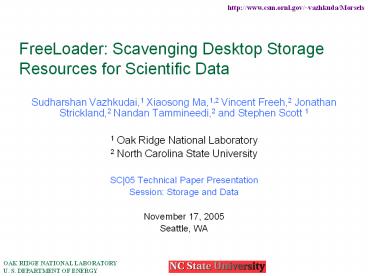FreeLoader: Scavenging Desktop Storage Resources for Scientific Data - PowerPoint PPT Presentation
Title:
FreeLoader: Scavenging Desktop Storage Resources for Scientific Data
Description:
FreeLoader: Scavenging Desktop Storage Resources for Scientific Data Sudharshan Vazhkudai,1 Xiaosong Ma,1,2 Vincent Freeh,2 Jonathan Strickland,2 Nandan Tammineedi,2 ... – PowerPoint PPT presentation
Number of Views:87
Avg rating:3.0/5.0
Title: FreeLoader: Scavenging Desktop Storage Resources for Scientific Data
1
FreeLoader Scavenging Desktop Storage Resources
for Scientific Data
- Sudharshan Vazhkudai,1 Xiaosong Ma,1,2 Vincent
Freeh,2 Jonathan Strickland,2 Nandan Tammineedi,2
and Stephen Scott 1 - 1 Oak Ridge National Laboratory
- 2 North Carolina State University
- SC05 Technical Paper Presentation
- Session Storage and Data
- November 17, 2005
- Seattle, WA
2
Outline
- Problem space
- Desktop storage scavenging for scientific data
- FreeLoader architecture
- FreeLoader performance in a users HPC setting
- Philosophizing
- Wrap up on a funny note!
3
Problem Domain
- Data Deluge
- Experimental facilities SNS, LHC (PBs/yr)
- Observatories sky surveys, world-wide telescopes
- Simulations from NLCF end-stations
- Internet archives NIH GenBank (serves 100
gigabases of sequence data) - Typical user access traits on large scientific
data - Download remote datasets using favorite tools
- FTP, GridFTP, hsi, wget
- Shared interest among groups of researchers
- A Bioinformatics group collectively analyze and
visualize a sequence database for a few days
Locality of interest! - Often times, discard original datasets after
interest dissipates
4
So, whats the problem with this story?
- Wide-area data movement is full of pitfalls
- Sever bottlenecks, BW/latency fluctuations
- GridFTP-like tuned tools not widely available
- Popular Internet repositories still served
through modest transfer tools! - User applications are often latency intolerant
- e.g., real-time viz rendering of a TerraServer
map from Microsoft on ORNLs tiled display! - Why cant we address this with the current
storage landscape? - Shared storage Limited quotas
- Dedicated storage SAN storage is a non-trivial
expense! (4TB disk array 40K) - Local storage Usually not enough for such large
datasets - Archive in mass storage for future accesses High
latency - Upshot
- Retrieval rates significantly lower than local
I/O or LAN throughput
5
Is there a silver lining at all? (Desktop Traits)
- Desktop Capabilities better than ever before
- Space usage to Available storage ratio is
significantly low in academic and industry
settings - Increasing numbers of workstations online most of
the time - At ORNL-CSMD, 600 machines are estimated to be
online at any given time - At NCSU, gt 90 availability of 500 machines
- Well-connected, secure LAN settings
- A high-speed LAN connection can stream data
faster than local disk I/O
6
Desktop Storage Scavenging?
- FreeLoader
- Imagine Condor for storage
- Harness the collective storage potential of
desktop workstations Harnessing idle CPU cycles - Increased throughput due to striping
- Split large datasets into pieces, Morsels, and
stripe them across desktops - Scientific data trends
- Usually write-once-read-many
- Remote copy held elsewhere
- Primarily sequential accesses
- Data trends LAN-Desktop Traits user access
patterns make collaborative caches using storage
scavenging a viable alternative!
7
Old wine in a new bottle?
- Key strategies derived from best practices
across a broad range of storage paradigms - Desktop Storage Scavenging from P2P systems
- Striping, parallel I/O from parallel file systems
- Caching from cooperative Web caching
- And, applied to scientific data management for
- Access locality, aggregating I/O, network
bandwidth and data sharing - Posing new challenges and opportunities
heterogeneity, striping, volatility, donor
impact, cache management and availability
8
FreeLoader Environment
9
FreeLoader Architecture
- Lightweight UDP
- Scavenger device metadata bitmaps, morsel
organization - Morsel service layer
- Monitoring and Impact control
- Global free space management
- Metadata management
- Soft-state registrations
- Data placement
- Cache management
- Profiling
10
Testbed and Experiment setup
- FreeLoader installed in a users HPC setting
- GridFTP access to NFS
- GridFTP access to PVFS
- hsi access to HPSS
- Cold data from tapes
- Hot data from disk caches
- wget access to Internet archive
11
Comparing FreeLoader with other storage systems
12
Client Access-pattern Aware Striping
- Uploading client likely to access more frequently
- So, lets try to optimize data placement for him!
- Overlap network I/O with local I/O
- What is the optimal localremote data ratio?
- Model
13
Striping Parameters
14
Client-side Filters
15
Computation Impact
16
Network Activity Test
17
Disk-intensive Task
18
Impact Control
19
Philosophizing
- What the scavenged storage is not
- Not a file system, not a replacement to high-end
storage - Not intended for wide-area resource integration
- What it is
- Low-cost, best-effort storage cache for
scientific data sources - Intended to facilitate
- Transient access to large, read-only datasets
- Data sharing within administrative domain
- To be used in conjunction with higher-end storage
systems
20
(No Transcript)































